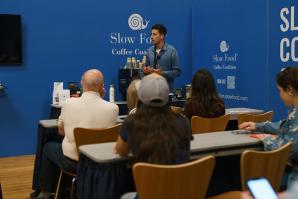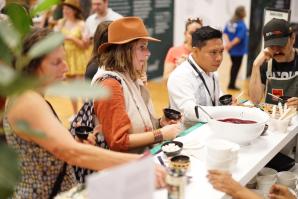San Joaquin County — with its rich cultural and historical heritage in both rural communities and city centers — may soon have a unified creative and cultural front. For the first time since 2001, the county will again have an arts council. A grant-funded, multi-year initiative, spearheaded by Amador County Arts Council Executive Director Meghan O’Keefe in collaboration with San Joaquin arts organizations, aims to connect the county’s diverse artistic landscape and bring new opportunities to its nearly 800,000 residents.
Funded through the California Arts Council’s State Local Partner Mentorship program, the council aspires to introduce San Joaquin County to state-level programs like Poetry Out Loud and bring in additional funding for artists organizations and artists in the region.
One of the council’s primary objectives will be to bridge the gap between geographically and culturally disparate communities and foster collaboration and equitable access to resources throughout. Disproportionately split between urban and rural settings, the San Joaquin creative sector is a diverse landscape with varying needs for services, engagement and resources.
During several community input sessions, organizers explain the
vision for a decentralized council and seek input from community
members and art organizations. (Photo courtesy of Meghan O’Keefe)

The decentralized model
An arts council, typically a nonprofit or government agency, functions as a “state-local partner” at the county level, channeling funds into local arts programs, promoting the county’s arts and culture while bolstering the economy. Typically, an arts council will operate out of one primary location, often the county seat or most densely populated city, but it doesn’t have to.
O’Keefe believes that for the diverse populations of San Joaquin County, a decentralized model is the perfect solution to support the creative sector and promote arts and culture in San Joaquin as a whole.
“San Joaquin County is the largest county that doesn’t have an art council,” O’Keefe says, referring to counties in California.
“And it has a plethora, an abundance of vibrant art organizations, cultural organizations, individual artists, community groups, arts and municipality partnerships. The arts and cultural and creativity landscape in San Joaquin County is flourishing, but it lacks the overarching art council umbrella that connects all of those voices together and makes sure that all the pieces and parts feel connected, feel community, feel collective work and that everyone gets access to these resources.”
The project aims to serve both urban and rural areas without competing with the dozens of existing arts organizations already providing services. Instead of creating a brand new entity, the San Joaquin Arts Council steering committee — currently made up of O’Keefe, Hatch Workshop Co-founder and Executive Director Elazar Abraham and Jessica Fong, executive director of Stockton Art League — seeks to unify existing organizations under the San Joaquin Arts Council umbrella with designated partner organizations in each of several proposed districts.
What does San Joaquin need?
Fong and Abraham, both Stockton residents and board members for the nonprofit Stockton Arts Foundation, identified a need for a unified art scene and, most importantly, streamlined and equitable access to resources such as grant funding and program support typically made available through arts councils.
Jessica Fong, executive director of Stockton Art League and
Stockton Arts Foundation board member, believes the project will
bring resources and opportunities to existing arts organizations
in the region by highlighting, not duplicating their work. (Photo
courtesy of Jessica Fong)

“Only one of the administering organizations, the Kern Dance Alliance, had a specific focus that included San Joaquin,” Abraham says. “Of the applications that were funded, only one of the organizations even included San Joaquin in their service region, so if you look at the program all the way through, it appears that it barely got more than $100,000 at most into San Joaquin County out of $60 million,” she adds. “We have to share information about this stuff and educate the community on what these gaps are and how extreme they are.”
One barrier for San Joaquin residents is an unequal distribution of resources, particularly for those in rural communities.
“We have a very unique community at the county level being that we’re not rural endpoints, and we’re not urban endpoints, and we serve over 700,000 people as a county. Almost 400,000 of that is Stockton, but there’s so much more to our community than just each city,” Fong says.
Abraham questions whether a Lockeford resident would prefer applying for a grant in Manteca, Lodi or locally, highlighting the need for more community input before deciding on the council’s structure. So far, input has been received through an online survey and a handful of community input sessions held in Tracy, Lodi and Stockton. Now the committee is seeking participation at the organizational level.
“When we get to really identifying the model and the framework, I would like to see something involving applications for organizations within regions and regions drawn,” Abraham says.
Figuring out how to create equity across the county with population and political disparities is one of the challenges ahead for the arts council. Another is determining what the public actually wants and needs.
Elazar Abraham, co-founder and executive director of Hatch
Workshop in Stockton, is one of three steering committee members
focused on launching an Arts Council in San Joaquin County.
(Photo by Natalie Petersen)

The committee has applied for a second grant of $50,000 through the State Local Partner Mentorship program, which would fund the hiring of staff such as an executive director to begin developing the arts council’s programs. Currently, the San Joaquin Arts Council is fiscally sponsored by the Amador County Arts Council and in the process of establishing its own 501(c)(3) nonprofit status.
“The Arts Council is not here to create new programming or do more art classes or do a concert every year,” Fong says. “That is not our focus. We already have amazing organizations and amazing artists who already do those things. We’re just here to highlight their work and what they’re doing, give credit to those who are already doing the work. So we’re not trying to duplicate those things. What we can do is highlight them. We can provide them with resources and opportunities to better fund their programs.”
–
Subscribe to the Comstock’s newsletter today.
Recommended For You
At Patrick and Bobbin Mulvaney’s Restaurant, Ingredients and Compassion for the Community Are Locally Sourced
An extraordinary night with an extraordinary couple
For Patrick and Bobbin Mulvaney, the long-married couple whose restaurant Mulvaney’s B&L is on the top of almost everyone’s fine-dining list in the Capital Region, two words seem to coexist as a single mission statement: nourish and nurture.

Sacramento Goes Global With New Food Conference
Terra Madre has potential to shine a ‘huge culinary spotlight’ on the city
Sacramento will serve as the site of a prestigious international food conference that could eventually bring thousands of tourists and millions of dollars into the region.

Vino Madre
Juicy scenes from the wine tasting room at the first Terra Madre Americas
For three days in May, the floor of the Memorial Auditorium was transformed into a global foodways classroom where one could sample coffee from Honduras, eat a cookie made from Bolivian quinoa and spin an oversized wheel that directed you to pithy sayings by food journalist Michael Pollan.

From Farm to Glass
They’re just miles apart, but Capital Region wine regions are distinctively different based on their climate, terrain and soil
Each of our four wine regions has its own unique terroir, a French term describing the soil, climate and sunshine that give wines their distinct character. These winemakers want consumers to consider their wines farm-to-fork — that is, farm-to-glass.



